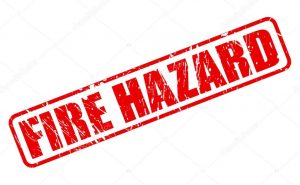A Fire Risk Assessment should be completed by a competent person. Alternatively, you can use the services of a specialist company, like ourselves, who can cast a professional eye over your premises and ensure nothing gets missed.
There are 5 steps to your Risk Assessment:
1. Fire Hazards
2. People at Risk
3. Evaluate & Act
4. Record, Plan & Train
5. Review
The first step is to identify fire hazards. Basically, this means pinpointing the potential sources of heat which can be done by carrying out a site survey and taking note of anything that could generate heat or naked flames. You will also need to identify all combustible materials on your premises such as paper, plastic, cardboard, fuels, chemicals etc. When considering this, it is useful to understand the definition of a fire hazard.
What are fire hazards?
A fire hazard has 2 components; one is the possibility of a fire occurring and the other is the level of consequences of that fire. For example, a metal workshop will have a high possibility of a fire occurring because of processes like the cutting/welding of equipment. But, providing housekeeping is good and no combustible substances are present, a fire is not likely to spread so the consequence of that fire is low. 
All workplaces will contain heat/ignition sources. Some will be obvious, such as cooking equipment or open flames, but others will be much less obvious.
We have made a list of some possible sources of ignition for you to consider…
– Matches, lighters, candles and smoking materials
– Defective electrical fittings
– Overloaded plug sockets
– Damaged or faulty wiring
– Misuse of electrical extension leads/adapters
– Ovens, kilns, furnaces etc
– Portable heaters
– Flame/sparks from work processes such as welding/cutting/grinding etc
– Cooking equipment
– Boilers, engines and other oil burning equipment
– Arson threats should not be overlooked
We have also put together a list of potential sources of fuel and unsafe situations….
– Combustibles
1. Combustible fuels – paper, wood, cardboard etc
2. Highly combustible fuels – thinners, solvents etc
– Unsafe procedures; actions such as smoking next to combustible materials
– Unsafe conditions; hazards that may assist a fire to spread e.g. open stairs that can cause a fire to spread quickly, trapping people and involving the whole building
– One hazard that is often overlooked is bad housekeeping. Yet this is the easiest to correct!
Please note: the above lists are by no means exhaustive and have been provided merely as a guide. If you are having trouble with Fire Risk Assessments, contact our team today.
